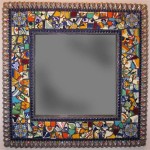Can a Convex Mirror Form a Magnified Virtual Image?
Convex mirrors, characterized by their outwardly curved reflecting surface, are known for producing virtual, upright, and diminished images. This leads to the common misconception that they cannot form magnified images. However, a closer examination of the image formation process reveals a more nuanced understanding.
To understand how images are formed by convex mirrors, it's crucial to grasp the principles of reflection. Light rays incident on the mirror's surface are reflected according to the law of reflection: the angle of incidence equals the angle of reflection. These reflected rays, when extended backward, appear to converge behind the mirror, forming a virtual image. This image is virtual because the light rays do not actually converge at that point; rather, they appear to originate from it.
The location and size of the image formed by a convex mirror are determined by the object's distance from the mirror and the mirror's focal length. The focal length of a convex mirror is negative, indicating that the focal point is located behind the mirror. This negative focal length plays a crucial role in the image formation characteristics.
The mirror equation, 1/f = 1/do + 1/di, relates the focal length (f), object distance (do), and image distance (di). For convex mirrors, since f is negative and do is positive, di will always be negative. A negative image distance signifies a virtual image located behind the mirror.
Magnification (M) is defined as the ratio of the image height (hi) to the object height (ho) and is also related to the object and image distances: M = -di/do. Since di is always negative for convex mirrors, the magnification is always positive, indicating an upright image. Furthermore, because the absolute value of di is always smaller than do for convex mirrors, the magnification is always less than 1, which typically results in a diminished image.
The question remains: can a convex mirror ever produce a magnified virtual image? The answer lies in understanding the limiting case. Consider an object placed infinitely far from the mirror. As do approaches infinity, the term 1/do in the mirror equation approaches zero. This simplifies the equation to 1/f = 1/di, or di = f. In this scenario, the image forms at the focal point, and the magnification approaches zero. The image becomes infinitely small and located at the focal point.
Now, consider bringing the object closer to the mirror. As the object distance decreases, the absolute value of the image distance (|di|) increases, and therefore, the magnification also increases. While the magnification remains less than 1, it approaches 1 as the object approaches the mirror's surface. In the theoretical limit, as the object distance approaches zero, the image distance also approaches zero, and the magnification approaches 1. This means the virtual image gets progressively larger as the object moves closer to the mirror's surface, although it will never exceed the size of the object itself.
Therefore, while a convex mirror cannot produce a magnified virtual image in the conventional sense (where magnification is greater than 1), the size of the virtual image does increase as the object is brought closer to the mirror's surface. The image will appear larger than it would if the object were farther away, approaching the object's size as the object approaches the mirror. This increase in size, while not technically magnification in terms of exceeding the object's size, can be perceived as a form of relative magnification compared to the image formed when the object is further from the mirror's surface.
It’s important to distinguish this from the magnification observed with concave mirrors, which can produce virtual images with magnification greater than 1. Convex mirrors, due to their diverging nature, will always produce images smaller than the object when the object is placed at a finite distance. The perceived increase in size as the object approaches the mirror should be understood as a relative increase within the context of the convex mirror’s image formation properties, rather than true magnification exceeding unity.
The unique properties of convex mirrors make them suitable for a variety of applications, such as security mirrors, vehicle side mirrors, and in some optical instruments. Their ability to provide a wide field of view, albeit with diminished images, is a key advantage in these applications. The apparent increase in image size as objects approach the mirror, even without exceeding the object's actual size, contributes to their effectiveness in certain contexts.
Can A Convex Mirror Form Magnified Image Quora
Can A Convex Mirror Form Magnified Image Quora
Why Do Convex Mirrors Always Form A Virtual Image Quora
Can A Convex Mirror Form Real Image Quora

Image Formation By Convex Mirrors
Under What Condition Do Converging Lines Form A Virtual Image Quora

Virtual Image Wikipedia

Concave Mirrors And Convex Ray Diagrams Image Formation Examples
Can A Convex Mirror Form Real Image Quora

Concave Mirrors And Convex Ray Diagrams Image Formation Examples








